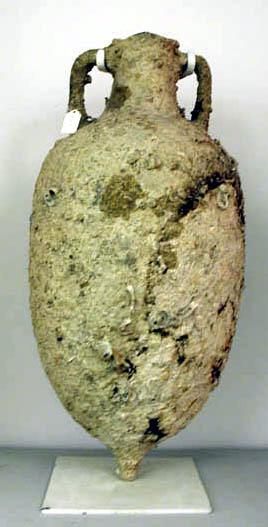
Amphora
Culture: Ancient Greek
Date: 3rd century BCE
Period: Greco-Roman
Medium: Terracotta and encrustations
Dimensions:
29 1/2 × 13 × 13 in. (74.9 × 33 × 33 cm)
Classification: 3-D Object/Sculpture
Object number: CA 6151
Not on view
DescriptionSquat vessel with an hourglass-shaped neck that flares to the open mouth, two long curving handles that join to the sloping shoulder, and an elongated globular body that comes to a point in a solid spike foot. Rim is broken, only preserving a portion of a gently rounded lip. Reddish fabric visible along the break at the rim. Encrustations and concretions, off-white in color, all around the surface.
EssayThis transport and storage jar (amphora, plural amphorae) is a shape that was used in the Aegean between the 1st and 3rd centuries CE to convey olive oil. Like the wine transported in other amphorae in the collection (CA 5857, CA 6050, and others), olive oil was an important and widely exported commodity in the Aegean. The form of this vessel, with its globular body, long curving handles, and hourglass neck, categorizes it as a Dressel 24 type. In 1899, archaeologist Heinrich Dressel systematically studied and classified these vessels, and his cataloguing system continues to be used (with additional refinements) by scholars today. The pointed end of this amphora, like other transport amphorae, allowed for the compact storage of these vessels in cargo holds of ships. Many were recovered underwater where they were lost during transport. Little is known about this vessel's archaeological context, but it was recovered off the coast of Attica in the Aegean Sea.
Public Website: No

